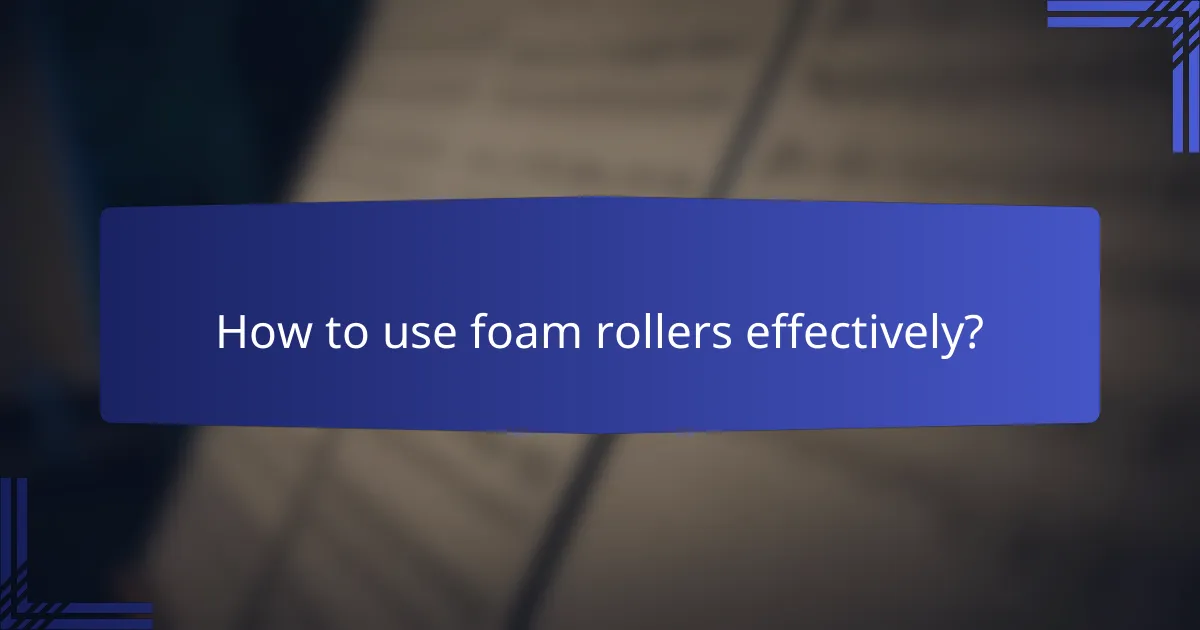Foam rollers are essential tools for muscle recovery, offering benefits such as improved blood circulation, reduced soreness, and enhanced flexibility. By targeting muscle knots and tension, they help athletes and fitness enthusiasts recover more efficiently and perform at their best. With various textures and densities available, users can select the right foam roller to meet their specific needs and preferences.

How do foam rollers aid muscle recovery?
Foam rollers aid muscle recovery by promoting blood circulation, alleviating soreness, and improving flexibility. These benefits help athletes and fitness enthusiasts recover faster and perform better in their activities.
Increased blood flow
Using a foam roller increases blood flow to the muscles, which is essential for recovery. Enhanced circulation delivers more oxygen and nutrients to the tissues, helping to repair any damage from exercise.
To effectively increase blood flow, spend 1-2 minutes rolling over each muscle group, focusing on areas that feel tight or sore. This practice can be especially beneficial after intense workouts.
Reduced muscle soreness
Foam rolling can significantly reduce muscle soreness, often referred to as delayed onset muscle soreness (DOMS). By breaking up adhesions and knots in the muscle fibers, foam rollers help alleviate discomfort.
For optimal results, use the foam roller immediately after workouts or within a few hours. Aim for 10-15 minutes of rolling to help minimize soreness and improve recovery times.
Enhanced range of motion
Foam rollers enhance the range of motion by loosening tight muscles and fascia, which can restrict movement. Improved flexibility allows for better performance in physical activities and reduces the risk of injury.
Incorporate foam rolling into your warm-up routine to prepare your muscles for exercise. Focus on major muscle groups, such as the quadriceps, hamstrings, and back, spending about 30 seconds on each area to maximize benefits.

What are the best foam rollers for pain relief?
The best foam rollers for pain relief are those designed to effectively target muscle knots and tension, enhancing recovery and flexibility. Options vary in texture, density, and size, allowing users to choose based on their specific needs and preferences.
TriggerPoint GRID Foam Roller
The TriggerPoint GRID Foam Roller is known for its unique grid pattern that mimics the hands of a massage therapist. This design helps to release muscle tightness and improve blood flow, making it ideal for post-workout recovery.
When using the TriggerPoint GRID, focus on rolling slowly over sore areas to maximize relief. It is available in various sizes, with the standard model being about 13 inches long, making it portable and easy to store.
LuxFit Foam Roller
The LuxFit Foam Roller offers a smooth surface that is excellent for beginners and those seeking gentle muscle relief. It is made from high-density foam, providing durability and support for various exercises and stretches.
This roller is typically 36 inches long, allowing for full-body use, including back and legs. It is recommended to incorporate it into your routine for at least 10 minutes daily to see improvements in flexibility and pain reduction.
RumbleRoller Foam Roller
The RumbleRoller Foam Roller features a textured surface with raised bumps that target deeper muscle layers. This roller is particularly effective for those who experience chronic pain or are athletes looking for intense muscle recovery.
While using the RumbleRoller, apply moderate pressure to avoid excessive discomfort. It comes in different sizes, with the standard length being 31 inches, making it suitable for various body types and areas.

How to use foam rollers effectively?
To use foam rollers effectively, focus on specific muscle groups, apply consistent pressure, and incorporate breathing techniques. This approach enhances muscle recovery, alleviates pain, and improves flexibility.
Target specific muscle groups
Identifying and targeting specific muscle groups is essential for effective foam rolling. Focus on areas that feel tight or sore, such as the quadriceps, hamstrings, calves, and back. Spend about 30 seconds to 2 minutes on each muscle group to maximize benefits.
For instance, when rolling your calves, position the foam roller under your lower leg and use your body weight to apply pressure. Adjust your position to target the inner and outer parts of the muscle for a more comprehensive release.
Maintain consistent pressure
Maintaining consistent pressure while foam rolling helps to break down muscle knots and improve blood flow. Apply enough weight to feel discomfort, but avoid excessive pain that could lead to injury. A good rule of thumb is to keep pressure steady for 30 seconds to a minute on each area.
To achieve this, use your hands or other body parts to control your weight distribution. If you find a particularly tight spot, pause and hold pressure there for a few extra seconds before continuing.
Incorporate breathing techniques
Incorporating breathing techniques during foam rolling can enhance relaxation and effectiveness. Focus on deep, controlled breaths to help release tension in the muscles. Inhale deeply as you roll over a tight area, and exhale slowly to facilitate muscle relaxation.
Try to synchronize your breathing with your movements. For example, inhale as you roll onto a tight spot and exhale as you release the pressure. This practice not only aids in muscle recovery but also promotes a calming experience.

What are the key features to consider when buying a foam roller?
When purchasing a foam roller, consider factors such as density, size, and surface texture. These features significantly impact the roller’s effectiveness for muscle recovery, pain relief, and improving flexibility.
Density and firmness
The density and firmness of a foam roller determine how much pressure it applies to your muscles. Softer rollers are generally better for beginners or those with sensitive areas, while firmer options provide deeper tissue massage for more experienced users. Consider your pain tolerance and recovery needs when selecting the right density.
Foam rollers typically range from low-density (soft) to high-density (firm). A medium-density roller is often a good compromise, offering enough firmness for effective muscle relief without being overly painful.
Size and portability
Foam rollers come in various sizes, typically ranging from 30 cm to 90 cm in length. A longer roller can accommodate larger muscle groups, while shorter ones are more portable and easier to store. If you plan to travel or use the roller in different locations, consider a compact model.
Additionally, thickness can vary. Thinner rollers are lighter and easier to carry, but may not provide the same level of support as thicker options. Choose a size that fits your workout routine and lifestyle.
Surface texture
The surface texture of a foam roller affects how it interacts with your muscles. Smooth rollers provide a gentle massage, suitable for beginners or those looking for a light recovery session. Textured rollers, with ridges or bumps, can target specific muscle knots and provide a more intense massage experience.
When selecting a surface texture, think about your goals. If you’re focusing on deep tissue work, a textured roller may be beneficial. For general use or sensitive areas, a smooth surface might be preferable.

What are the benefits of foam rolling for flexibility?
Foam rolling offers several benefits for flexibility by promoting muscle relaxation and improving range of motion. Regular use can enhance overall mobility, making it easier to perform daily activities and athletic movements.
Improved muscle elasticity
Foam rolling helps to break down adhesions and knots in muscle tissue, which can restrict elasticity. By applying pressure to specific areas, it encourages blood flow and nutrient delivery, aiding in muscle recovery and flexibility.
To maximize muscle elasticity, aim to foam roll major muscle groups like the quadriceps, hamstrings, and calves for about 1-2 minutes each. This practice can be particularly effective before workouts to prepare muscles for activity.
Enhanced athletic performance
Incorporating foam rolling into your routine can lead to improved athletic performance by increasing flexibility and reducing muscle soreness. This can result in better movement efficiency and higher levels of endurance during physical activities.
For athletes, foam rolling sessions lasting 10-15 minutes before and after workouts can help maintain optimal muscle function. This approach can be especially beneficial in sports that require agility and quick movements.
Reduced risk of injury
Foam rolling can significantly reduce the risk of injury by improving flexibility and muscle balance. By addressing tight muscles and enhancing recovery, it helps to prevent strains and overuse injuries.
To effectively reduce injury risk, incorporate foam rolling into your post-workout routine. Focus on areas that feel tight or fatigued, and consider using a foam roller regularly, especially during high-intensity training periods.
